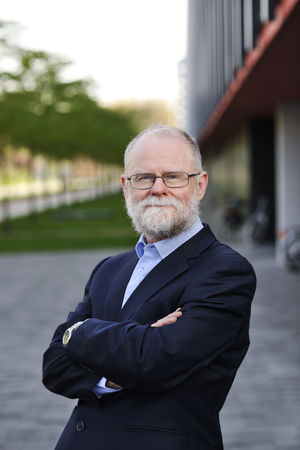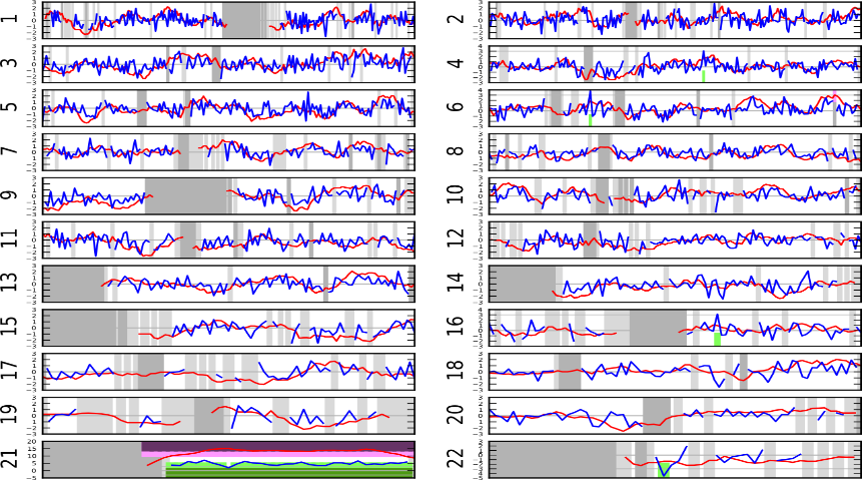Towards a sensible digital society
Mathematics, electrical engineering and computer science are the foundation of modern technology: they form the basis for solutions to this century's major challenges. This creates not only opportunities but also responsibilities. "As engineers, we must be aware of the fact that the digital society does not exclusively bring benefits", warns Professor John Schmitz, Dean of the Faculty of Electrical Engineering, Mathematics and Computer Science (EEMCS).
 Mathematics, (micro)electronics and computer science: all technical systems and hardware – from medical equipment to aircraft – require a combination of these three elements. "Take your smartphone", Professor Schmitz explains. "It contains electronic switches – integrated circuits. Designing them requires mathematics. Consider Kirchhoff's laws, which state that the sum of the voltages at a node in such a circuit equals zero; the same applies to the resistance in a loop. Solving such equations for simple circuits is manageable, but one modern integrated circuit (or microchip) contains millions of these loops. To do that, you really need to know your mathematics".
Mathematics, (micro)electronics and computer science: all technical systems and hardware – from medical equipment to aircraft – require a combination of these three elements. "Take your smartphone", Professor Schmitz explains. "It contains electronic switches – integrated circuits. Designing them requires mathematics. Consider Kirchhoff's laws, which state that the sum of the voltages at a node in such a circuit equals zero; the same applies to the resistance in a loop. Solving such equations for simple circuits is manageable, but one modern integrated circuit (or microchip) contains millions of these loops. To do that, you really need to know your mathematics".
Smartphones now have 100,000 times the computing power of the computers that were used for the moon landing. This was made possible by the development of micro-electronics, which in turn influenced the development of mathematics and computer science. "In the past, mathematics required a great deal of analytical solving. Current computing power and numerical methods mean we can simply calculate it all. This offers unprecedented possibilities," notes Schmitz. "In addition, all sorts of things that used to require experimental demonstration can now be partly calculated; so we don't have to conduct as many expensive experiments". Mathematics, computer science and electronics reinforce each other in this way, and are the joint foundation of modern technology – a role that Schmitz wants to put in the spotlight.
Healthcare
One topic that does not immediately bring EEMCS to mind is healthcare. The use of stem cells to grow tissue on electronic chips (‘Organ on Chip’) now makes it possible to conduct highly specific studies of how medicines work, in order to develop personalised individual medication. In the Bio-Informatics and Pattern Recognition research group, researchers are applying advanced data analysis in order to be able to interpret and use the ever-expanding volume of biological data (e.g. from DNA sequencing). Great things are happening in the field of medical imaging as well. "Take MRI scanners, which cost millions because of the linear magnets they require. Although these magnets have been fully optimised over time, the best possible technology is not being used to process the signals into images", explains Schmitz. "A combination of simple magnets and sophisticated image processing can produce very good image quality. This makes the devices affordable for developing countries as well".

Great things are happening in the field of medical imaging as well. "Take MRI scanners, which cost millions because of the linear magnets they require. Although these magnets have been fully optimised over time, the best possible technology is not being used to process the signals into images", explains Schmitz. "A combination of simple magnets and sophisticated image processing can produce very good image quality. This makes the devices affordable for developing countries as well".
However, even more information can be extracted from the more expensive scanners. "That kind of system generates a mountain of data, only a small portion of which is used in constructing two-dimensional images. By using symbols – glyphs – to represent this sea of data, computer-graphics techniques can be used to generate visual insight into all kinds of processes taking place in the tissue. The current systems can't do that. Of course, serious mathematics lies behind all this", says Schmitz. "It’s about how we visualise information in a way that humans can understand. Computer graphics could also be helpful in the cockpit, where pilots see so much data flash by that they can hardly make anything of it".
Energy transition
The energy transition has been called the greatest challenge of this century. According to Schmitz, this is no empty claim: "Worldwide, the majority of our energy still comes from fossil fuels. That has soon to change to 100% green energy, and electric energy will play an important role in the process". The generation of sustainable energy, the storage and conversion of energy, smart energy networks: the researchers at EEMCS are working on all the areas that will make this possible. The transition from centralised to decentralised generation and distribution will play a major role here: "Energy is increasingly becoming a two-way street. For example, locally generated energy can be delivered to the net or perhaps stored temporarily in car batteries. The network will also have to be able to cope with fluctuating supplies of solar and wind energy. We will soon be able to test exactly how that works in our new system-integration lab". Schmitz is referring to the Electrical Sustainable Power Lab (ESP Lab), a unique facility for research on the integration of all these new technologies into a single sustainable energy system.
Blockchain
While traditional customers are increasingly becoming ‘prosumers’ of energy, so the number of transactions is also increasing. Soon there will be questions to be answered, such as how do you charge for energy you have supplied to a neighbour. Blockchain technology – a new form of safe, distributed data storage – could be useful in this context. "Blockchain aims to generate digital confidence. That is quite an achievement in an age when our confidence in institutions is so often being undermined", argues Schmitz. How does it work? "Blockchain encrypts documents or data, and then it generates a unique code: a hash. This is done in such a way that the hash changes if something in the document changes. This means that any fraud is immediately revealed". Confidence in blockchain also has to do with the fact that the storage of each document is spread across the internet, thereby making fraud or theft virtually impossible.

"Blockchain can be used for a large number of applications that currently require intermediaries, for example registering wills or taking out mortgages. It can also provide access to the financial world in areas where there are no banks", Schmitz points out. "It will soon be possible to use blockchain to arrange anything that now requires proof of identity". EEMCS is at the forefront of the development of blockchain technology. TU Delft is a founding member of the Dutch Blockchain Coalition, which is based on the campus. "All partners from society and industry are represented there: banks, government bodies, industry, notaries, insurance companies, knowledge institutions. It’s easier to interact with the field when it's so near".
Education
This community underpins the faculty’s aims in regard to its teaching duties. "We want to solve societal problems. This requires research, as well as engineers who are able to put that into practice. We train them, because engineers are needed in order to solve the world’s problems’, declares Schmitz. In his assessment, the teaching at TU Delft is in good shape. In a recent benchmark study by the Massachusetts Institute of Technology (MIT), TU Delft is ranked high amongst the world’s best universities of technology. "I would venture to say that the educational innovation at EEMCS is one reason that we are one of the top five in the world. The MIT report makes explicit mention of our Solar Energy MOOC and the 'blended-learning' approach in the teaching of maths."
The latter project is PRIME: Project Innovation Mathematics Education. "We teach mathematics across the entire university, so we have to be able to explain it well to non-mathematics students". A combination of videos, interactive quizzes and online homework is intended to provide students with comprehensible preparation for the lectures and to improve their mathematical foundations. "We will also soon be starting a 'digital-skills' project, in which all students will learn the basic elements of programming", notes Schmitz. In addition to imparting mathematics and digital skills, the project will also make sure students – and scientists – consider the potential risks of the digital society.
Risks
"Digitisation has a major influence on society. When you go to a restaurant, everyone is sitting there looking at their screens. Although we could debate about whether that is good or bad, it does have a major impact on daily life", argues Schmitz. "On the other hand, some people today still do not have any connection to the internet. Do they no longer count? The government already makes it nearly impossible to do a tax return on paper". Social exclusion is only one of the risks. Schmitz explains, "We can have computers train themselves to recognise images. For example, the neural network recognises whiskers and decides that it’s seeing a cat. In time, it trains itself by adjusting a variety of weighting factors in the neural network. Although there have been no problems so far, these systems are sometimes so complicated that we no longer understand what they are doing".
This could lead to potentially major dangers if, for example, we use the same systems to drive our cars, manage the stock market or arrive at medical diagnoses. We need to find ways to make deep learning and similar technologies more comprehensible. Otherwise, we could be heading for ‘Weapons of Math Destruction’, as the mathematician Cathy O’Neil describes in her book of the same name. In general, this is nothing new. "There are two sides to whatever we invent, good or bad", argues Schmitz. "As an engineer, it's important to make this visible, and therefore transparent".
Digital society
Until recently, this was uncharted territory. "These problems are on their way because the digital society is unstoppable. In fact, they are already here, although they are a relatively new issue. We need to be aware that these kinds of factors will be playing a role. This starts with the training of good engineers, and this means in education", observes Schmitz. Fortunately, we are not alone in this endeavour. For example, the ‘Digital Society’ programme of the Association of Universities in the Netherlands (VSNU) addresses both the opportunities and the risks. "The universities are united in saying, 'We are facing a common task'. Where is the human factor in the digital society? To what extent can we trust digital contacts and transactions? Even if we do not yet have the answers, I have high expectations that we will be able to find them if we all work together. This is how we can progress together towards a responsible digital society".